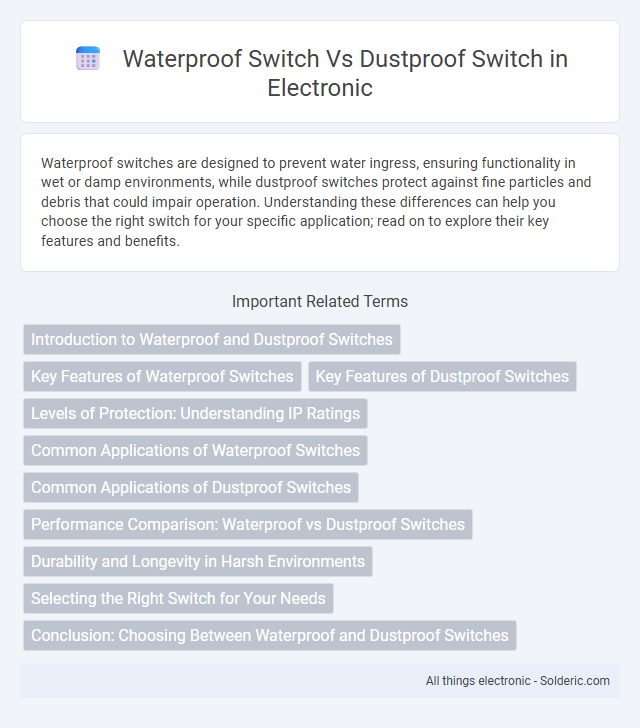Waterproof switches are designed to prevent water ingress, ensuring functionality in wet or damp environments, while dustproof switches protect against fine particles and debris that could impair operation. Understanding these differences can help you choose the right switch for your specific application; read on to explore their key features and benefits.
Comparison Table
| Feature | Waterproof Switch | Dustproof Switch |
|---|---|---|
| Primary Protection | Prevents water ingress | Prevents dust and particle ingress |
| IP Rating | Typically IP67 or higher | Typically IP5X to IP6X |
| Applications | Outdoor equipment, marine devices, bathrooms | Industrial machinery, clean rooms, electronics |
| Material | Sealed rubber or silicone gaskets | Tightly sealed enclosures, dust filters |
| Durability | Resistant to moisture and water pressure | Resistant to dust accumulation and abrasive particles |
| Common Standards | IEC 60529 IP67, IP68 | IEC 60529 IP5X, IP6X |
Introduction to Waterproof and Dustproof Switches
Waterproof switches safeguard electrical components from water ingress, ensuring reliable operation in wet environments with ratings such as IP67 or IP68. Dustproof switches prevent the entry of dust and particulate matter, maintaining functionality in dusty or sandy conditions with an emphasis on sealing and enclosure design. Selecting the appropriate switch depends on your specific environmental challenges to maximize durability and performance.
Key Features of Waterproof Switches
Waterproof switches are designed with sealed enclosures that prevent water ingress, ensuring functionality in wet or submerged environments. They typically feature high IP ratings such as IP67 or IP68, indicating resistance to both water and dust, whereas dustproof switches primarily block particulate matter without full water protection. Your choice should consider the operating conditions, with waterproof switches offering enhanced durability and reliability in harsh, moisture-prone settings.
Key Features of Dustproof Switches
Dustproof switches are designed with sealed enclosures and fine mesh filters to prevent ingress of dust particles, ensuring reliable operation in dusty or sandy environments. These switches typically comply with IP5X or higher ratings, indicating strong protection against solid contaminants without necessarily being water-resistant. Their durable construction and precise sealing mechanisms improve longevity and reduce maintenance needs in industrial and outdoor applications.
Levels of Protection: Understanding IP Ratings
Waterproof switches are rated with IP codes such as IP67 or IP68, indicating they provide complete protection against dust ingress (6) and varying degrees of water immersion (7 or 8). Dustproof switches typically have ratings like IP5X or IP6X, emphasizing protection against solid particles but offering limited or no water resistance. Understanding these IP ratings helps you select the right switch by balancing environmental exposure needs and ensuring durability in your application.
Common Applications of Waterproof Switches
Waterproof switches are commonly used in outdoor lighting systems, marine equipment, and automotive controls where exposure to water or moisture is frequent. These switches provide reliable operation in wet environments, preventing electrical failure caused by water ingress. Their robust sealing makes them ideal for use in irrigation systems, outdoor power tools, and industrial machinery requiring durability against water exposure.
Common Applications of Dustproof Switches
Dustproof switches are commonly used in industrial machinery, automotive controls, and consumer electronics where environments are exposed to dust and small particulate matter. These switches ensure reliable operation by preventing dust infiltration, which can cause malfunction or short circuits in devices such as HVAC systems, factory automation panels, and outdoor equipment. Unlike waterproof switches designed primarily for liquid resistance, dustproof switches prioritize protection against solid contaminants while maintaining sensitivity and durability.
Performance Comparison: Waterproof vs Dustproof Switches
Waterproof switches excel in preventing water ingress, making them ideal for environments with high moisture exposure or direct contact with liquids. Dustproof switches are engineered to block fine particles, ensuring reliable operation in dusty or sandy conditions but do not guarantee protection against water. Performance differences depend on the specific IP rating; IP67 or higher denotes superior waterproof capabilities, while IP5X or IP6X focuses on dust resistance, impacting switch longevity and reliability in targeted applications.
Durability and Longevity in Harsh Environments
Waterproof switches provide superior protection against moisture, preventing water ingress that can cause corrosion and electrical failures, thereby enhancing durability in wet or submerged conditions. Dustproof switches are designed to block dust and small particles, maintaining consistent performance by avoiding abrasion and interference within the switch mechanism. Both types extend longevity in harsh environments, with waterproof switches excelling in wet settings and dustproof switches ensuring reliability in dusty or sandy atmospheres.
Selecting the Right Switch for Your Needs
When selecting the right switch for your needs, consider the environmental exposure and specific protection requirements. Waterproof switches, certified with IP67 or higher, are ideal for applications involving water immersion or heavy moisture, ensuring reliable operation in wet conditions. Dustproof switches, typically rated IP5X or IP6X, prevent particle ingress in dusty or sandy environments, maintaining functionality where particulate contamination is a concern.
Conclusion: Choosing Between Waterproof and Dustproof Switches
Selecting between waterproof and dustproof switches depends primarily on the environmental conditions and specific application requirements. Waterproof switches provide superior protection against water ingress, making them ideal for wet or humid environments, while dustproof switches excel in preventing dust and particulate contamination in dry, dusty settings. Understanding the device's exposure to moisture versus dust is critical for optimizing switch longevity and performance in industrial, automotive, or outdoor installations.
waterproof switch vs dustproof switch Infographic

 solderic.com
solderic.com